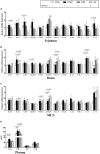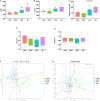Anethole Attenuates Enterotoxigenic Escherichia coli- Induced Intestinal Barrier Disruption and Intestinal Inflammation via Modification of TLR Signaling and Intestinal Microbiota
- PMID: 33841372
- PMCID: PMC8027122
- DOI: 10.3389/fmicb.2021.647242
Anethole Attenuates Enterotoxigenic Escherichia coli- Induced Intestinal Barrier Disruption and Intestinal Inflammation via Modification of TLR Signaling and Intestinal Microbiota
Abstract
This study aimed to investigate the effects of dietary anethole supplementation on the growth performance, intestinal barrier function, inflammatory response, and intestinal microbiota of piglets challenged with enterotoxigenic Escherichia coli K88. Thirty-six weaned piglets (24 ± 1 days old) were randomly allocated into four treatment groups: (1) sham challenge (CON); (2) Escherichia coli K88 challenge (ETEC); (3) Escherichia coli K88 challenge + antibiotics (ATB); and (4) Escherichia coli K88 challenge + anethole (AN). On day 12, the piglets in the ETEC, ATB, and AN group were challenged with 10 mL E. coli K88 (5 × 109 CFU/mL), whereas the piglets in the CON group were orally injected with 10 mL nutrient broth. On day 19, all the piglets were euthanized for sample collection. The results showed that the feed conversion ratio (FCR) was increased in the Escherichia coli K88-challenged piglets, which was reversed by the administration of antibiotics or anethole (P < 0.05). The duodenum and jejunum of the piglets in ETEC group exhibited greater villous atrophy and intestinal morphology disruption than those of the piglets in CON, ATB, and AN groups (P < 0.05). Administration of anethole protected intestinal barrier function and upregulated mucosal layer (mRNA expression of mucin-1 in the jejunum) and tight junction proteins (protein abundance of ZO-1 and Claudin-1 in the ileum) of the piglets challenged with Escherichia coli K88 (P < 0.05). In addition, administration of antibiotics or anethole numerically reduced the plasma concentrations of IL-1β and TNF-α (P < 0.1) and decreased the mRNA expression of TLR5, TLR9, MyD88, IL-1β, TNF-α, IL-6, and IL-10 in the jejunum of the piglets after challenge with Escherichia coli K88 (P < 0.05). Dietary anethole supplementation enriched the abundance of beneficial flora in the intestines of the piglets. In summary, anethole can improve the growth performance of weaned piglets infected by ETEC through attenuating intestinal barrier disruption and intestinal inflammation.
Keywords: Escherichia coli K88; anethole; antibiotics; microbiota; piglet.
Copyright © 2021 Yi, Liu, Zhang, Qiao, Chen, Zhang and Guan.
Conflict of interest statement
The authors declare that the research was conducted in the absence of any commercial or financial relationships that could be construed as a potential conflict of interest.
Figures





References
LinkOut - more resources
Full Text Sources
Other Literature Sources
Research Materials

